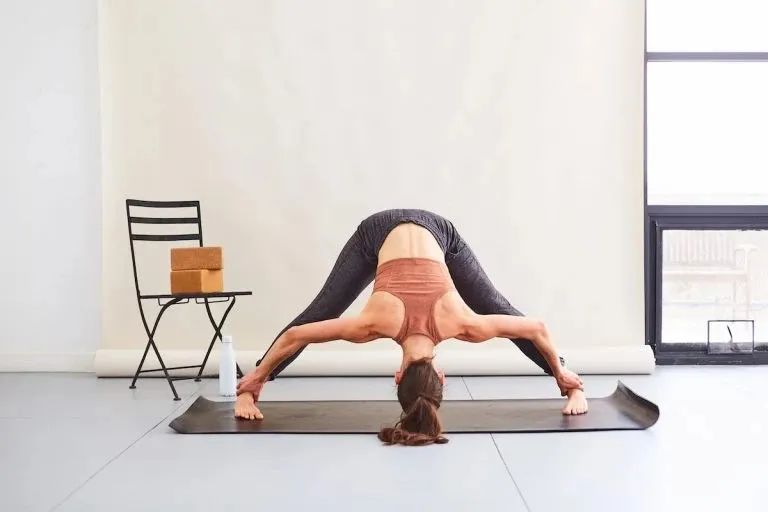When practicing yoga, you will always hear the teacher say that you should pay attention to protecting your knees.
For example, you can bend your knees slightly in the standing pose, or if you feel knee pain, you should withdraw from the pose immediately, and so on.
These are important because if you don’t do it properly, you can easily get hurt, especially your knees.
In the process of practicing yoga, there are three main situations of knee injury.
Part / 01 knee hyperextension is typical of standing three-dimensional and triangular extension.
Because the front thigh muscles do not start and exert force, they rely solely on the knee joint itself to be “hard”.
You can bend the knee slightly, activate the front thigh muscles, lift the knee (pay attention not to lock the knee), send the thigh bone to the pelvis, and straighten the leg instead of pushing the knee back.
Part / 02 the relative position of knees and ankles is wrong.
In the standing three-dimensional pose with one leg bending, the muscles on the outside of thighs are not activated, resulting in the knee not being straightened, or the key points of action are not mastered, resulting in the knee exceeding the ankle, such as warrior one and warrior two.
In the standing pose where the legs are bent together, the knees exceed the toes, such as the phantom chair pose.
Part / 03 the hip is not open, the hip is not open, and the knee is under additional pressure.
Hip joint, knee joint and ankle joint are the three joints connecting the lower limbs of human body.
If the hip joint does not move enough, it will exert excessive pressure on the knee joint in practice and make the knee joint overwhelmed.
The typical one is full lotus sitting.
When your hip joint does not have strong external rotation ability and the flexibility and extension ability of ankle and instep are insufficient, forcibly trying full lotus sitting can easily lead to knee injury.
From the above three situations, we can see that knee pain is often just a symptom.
If we hold the idea of “treating head pain and foot pain”, we can’t fundamentally solve knee pain.
Because the knee is between the pelvis and ankle, it plays a connecting role, so any instability of the foot and pelvis will affect the knee joint.
To protect the knee, you must stabilize the pelvis, which requires a strong core, hip abductor and hip muscles.
The new research also proves this.
As long as the core, hip abductor and hip muscles are strengthened, combined with the stretching of quadriceps femoris, knee pain can be relieved more effectively.
Today, we recommend several postures that can help strengthen the core, lateral hip and hip to stabilize the pelvis, relax the quadriceps femoris, fundamentally solve the problem of knee pain and give you a pair of healthy knees.
Key points of stretching against the wall: stand one step away from the wall, hold the wall with your right hand, bend your right leg backward, put the yoga belt around your right ankle, pull the yoga belt with your left hand, and lift your ankle close to your hip; Start the hip muscles, stretch the quadriceps femoris in the front of the thigh for 30 seconds, and repeat 3 times on the other side.
Efficacy: relax quadriceps femoris and strengthen hip muscles.
These two muscles are the key to prevent and treat anterior knee pain.
Key action points of soldiers: bend the front legs slowly to 90 ° as far as possible to make the lower thighs parallel to the ground; Activate the hip muscles, straighten the back legs and close to the midline; Press down on the ball and outside of your feet and lift the arch of your foot; Hold for 30 seconds and repeat 3 times on the other side.
Efficacy: strengthen the hip muscle of the back leg and stabilize the hip and ankle of the front leg.
Supine twist hand grasping big toe action points: lie on your back, cross your right leg over your body, and grasp your toes with your left hand; When you feel the stretch on the side of your hip, your legs fight against your hands or yoga belt, as if you want to come out of the pose; Turn the left leg outward slightly, activate the quadriceps femoris, including the rectus femoris, straighten the right leg and lift the knee to the correct position; Hold for 30 seconds and repeat 3 times on the other side.
Efficacy: stretch and strengthen hip abductor.
In yoga practice, in addition to strengthening and protecting the knee joint through these postures, we must pay attention to the three wrong methods that are easy to cause knee injury mentioned at the beginning of the article, eliminate the problem in the bud and try to avoid knee injury.
After all, health is the purpose of yoga.
Share, collect, like and watch..

